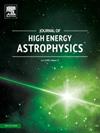BL Lacertae under the flare of 2024: Probing temporal and spectral dynamics
IF 10.5
4区 物理与天体物理
Q1 ASTRONOMY & ASTROPHYSICS
引用次数: 0
Abstract
In October 2024, the object BL Lacertae experienced the brightest flaring event in gamma-ray (>100 MeV) with a historically bright γ-ray flux of ∼2.59 erg cm−2 s−1 with a detection of a 175.7 GeV photon with Fermi-LAT. This event was also followed by very high-energy γ-ray detection with LHAASO, VERITAS, and MAGIC. Soon after, Swift-XRT and Swift-UVOT follow-up confirmed the concurrent flare in X-ray, UV, and optical bands. A minimum flux doubling/halving time of 1.06 ± 0.26 hour with 4σ significance has been observed with the Fermi-LAT orbit binned light curve. No compelling correlation has been found between γ-ray spectral indices and fluxes. The log-normal γ-ray flux distribution during the flare confirms the multiplicative nature of the non-linear perturbation causing the flare. We applied a one-zone leptohadronic model to fit the broadband SED during the flaring period. The broadband SED modeling reveals that the sudden enhancement of the magnetic field and bulk factor might promote the flare. The SED modeling also suggested a more compact emission region, which may be described by a shorter variability time than the observed one. The hadronic part best fitted the high energy part of the spectrum, suggesting the jets of BL Lac could provide a promising environment to accelerate the cosmic ray particles, such as protons. The jets of BL Lacertae could also be the possible source of astrophysical neutrinos, as an upper limit on neutrinos has already been reported from IceCube.
2024年耀斑下的花边BL:探测时间和光谱动力学
在2024年10月,天体BL Lacertae经历了伽马射线中最亮的耀斑事件(>100 MeV),历史上明亮的γ射线通量为~ 2.59 ×10−5 erg cm−2 s−1,费米- lat探测到175.7 GeV光子。这次事件之后,LHAASO、VERITAS和MAGIC也进行了高能γ射线探测。不久之后,Swift-XRT和Swift-UVOT随访证实了x射线,紫外和光学波段的并发耀斑。用Fermi-LAT轨道分束光曲线观测到的最小通量倍增/减半时间为1.06±0.26 h,具有4σ显著性。γ射线光谱指数与通量之间没有明显的相关性。在耀斑期间的对数正态γ射线通量分布证实了引起耀斑的非线性扰动的乘法性质。我们采用了一种单区垂子模型来拟合耀斑期的宽带SED。宽带SED模型表明,磁场和体积因子的突然增强可能会促进耀斑的发生。SED模型还显示了一个更紧凑的发射区域,可以用比观测到的更短的变率时间来描述。强子部分最符合光谱的高能部分,这表明BL Lac的喷流可能为加速宇宙射线粒子(如质子)提供了一个有希望的环境。BL Lacertae的喷流也可能是天体物理中微子的来源,因为冰立方已经报道了中微子的上限。
本文章由计算机程序翻译,如有差异,请以英文原文为准。
求助全文
约1分钟内获得全文
求助全文
来源期刊

Journal of High Energy Astrophysics
Earth and Planetary Sciences-Space and Planetary Science
CiteScore
9.70
自引率
5.30%
发文量
38
审稿时长
65 days
期刊介绍:
The journal welcomes manuscripts on theoretical models, simulations, and observations of highly energetic astrophysical objects both in our Galaxy and beyond. Among those, black holes at all scales, neutron stars, pulsars and their nebula, binaries, novae and supernovae, their remnants, active galaxies, and clusters are just a few examples. The journal will consider research across the whole electromagnetic spectrum, as well as research using various messengers, such as gravitational waves or neutrinos. Effects of high-energy phenomena on cosmology and star-formation, results from dedicated surveys expanding the knowledge of extreme environments, and astrophysical implications of dark matter are also welcomed topics.
 求助内容:
求助内容: 应助结果提醒方式:
应助结果提醒方式:


